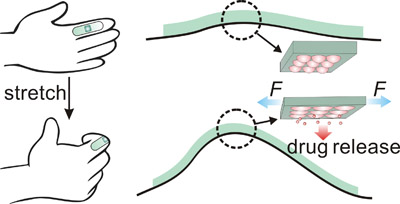Elastic Drug Delivery Technology Releases Drugs When Stretched
For Immediate Release
Researchers from North Carolina State University and the University of North Carolina at Chapel Hill have developed a drug delivery technology that consists of an elastic patch that can be applied to the skin and will release drugs whenever the patch is stretched.
For example, if applied to the elbow, the patch would release a drug when the elbow bends and stretches the patch.
“This could be used to release painkillers whenever a patient with arthritic knees goes for a walk, or to release antibacterial drugs gradually as people move around over the course of a day,” says Zhen Gu, co-senior author of a paper describing the work and an assistant professor in the joint biomedical engineering program at NC State and UNC-Chapel Hill.

The technology consists of an elastic film that is studded with biocompatible microcapsules. These microcapsules, in turn, are packed with nanoparticles that can be filled with drugs.
Here’s how it works: The microcapsules stick halfway out of the film, on the side of the film that touches a patient’s skin. The drugs leak slowly out of the nanoparticles and are stored in the microcapsules. When the elastic film is stretched, it also stretches the microcapsules – enlarging the surface area of the microcapsule and effectively squeezing some of the stored drug out onto the patient’s skin, where it can be absorbed.
“When the microcapsule is stretched from left to right, it is also compressed from bottom to top,” says Yong Zhu, co-senior author of the paper and an associate professor of mechanical and aerospace engineering at NC State. “That compression helps push the drug out of the microcapsule.”
After being stretched, the microcapsule is “re-charged” by the drugs that continue to leak out of the nanoparticles.
“This can be used to apply drugs directly to sites on the skin, such as applying anti-cancer medications to melanomas or applying growth factors and antibiotics for wound healing,” says Jin Di, co-lead author and a Ph.D student in Gu’s lab.
The researchers also incorporated microneedles into the system, applying them on top of the microcapsules. In this configuration, the drugs can be squeezed through the microneedles. The microneedles are small enough to be painless, but large enough to allow drugs to diffuse into the bloodstream through tiny capillaries underneath the skin. “This expands the range of drugs that can be applied using the technology,” says Shanshan Yao, co-lead author and a Ph.D student in Zhu’s lab.
“We’re now exploring how this tool can be used to apply drugs efficiently and effectively to burn patients, and we plan to look at how this could be used for pain relief as well,” Gu says.
“The materials are relatively inexpensive, and the manufacturing process is fairly straightforward, so we’re optimistic that this could be scaled up in a cost-effective way,” Zhu says.
The paper, “Stretch-Triggered Drug Delivery from Wearable Elastomers Containing Therapeutic Depots,” is published online in the journal ACS Nano. Co-authors include Yanqi Ye and Jicheng Yu of the joint biomedical engineering program, and Zheng Cui and Tushar Ghosh of NC State.
The work was supported by the American Diabetes Association, a pilot grant from UNC Chapel Hill’s NC TraCS Institute, and by the National Science Foundation through the ASSIST Engineering Research Center at NC State.
-shipman-
Note to Editors: The study abstract follows.
“Stretch-Triggered Drug Delivery from Wearable Elastomers Containing Therapeutic Depots”
Authors: Jin Di, Yanqi Ye, Jicheng Yu and Zhen Gu, North Carolina State University and University of North Carolina at Chapel Hill; Shanshan Yao, Zheng Cui, Tushar K. Ghosh and Yong Zhu, North Carolina State University
Published: online Aug. 10, 2015, ACS Nano
DOI: 10.1021/acsnano.5b03975
Abstract: Mechanical force-based stimulus provides a simple and easily accessible manner for spatiotemporally controlled drug delivery. Here we describe a wearable, tensile strain-triggered drug delivery device consisting of a stretchable elastomer and microgel depots containing drug loaded nanoparticles. By applying a tensile strain to the elastomer film, the release of drug from the micro-depot is promoted due to the enlarged surface area for diffusion and Poisson’s ratio-induced compression on the micro-depot. Correspondingly, both sustained drug release by daily body motions and pulsatile release by intentional administration can be conveniently achieved. Our work demonstrated that the tensile strain, applied to the stretchable device, facilitated release of therapeutics from micro-depots for anticancer and antibacterial treatments, respectively. Moreover, polymeric microneedles were further integrated with the stretch-responsive device for transcutaneous delivery of insulin and regulation of blood glucose levels of chemically-induced type 1 diabetic mice.
- Categories:


